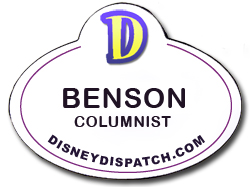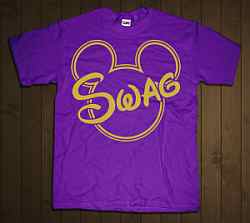FROM: It's All in a Nametag Published Thursdays
Disneyland's Light Magic Parade
When Disney creates a clunker, such as the Light Magic Parade, it pulls the curtain with minimal fanfare. Today, Benson pulls back the curtain on Disneyland's Light Magic Parade, a $20 million dollar bomb, and explains what went wrong.
Disneyland has seen many parades in its long 56 year history. Generally, they are the most popular attractions in the parks. People often save prime viewing spots along the parade route hours before the floats start rolling.
Nearly all parades at Disneyland, such as the Parade of Dreams which premiered in 2005 for the park's 50th anniversary, are beloved by guests. Some parades are created to promote whichever Disney film happens to be in theaters, such as the Hercules 'Zero to Hero' Victory parade or Aladdin's Magical Caravan. Others are created for a particular anniversary year of the park.
One parade, however, got little love: Disneyland's Light Magic.
The Main Street Electrical Parade
Before I tell you a bit about Light Magic, let's set the historical stage. The immediate predecessor to Light Magic was the much loved Main Street Electrical Parade (for the rest of this column I will call it the MSEP, so I don't have to type as much). It premiered at Disneyland on June 17, 1972, and ran for almost 25 years. It was most memorable for its synthesized soundtrack (which was a variation on the work 'Baroque Hoedown'). Most people remember the parade for the opening portion of its soundtrack: "Ladies and gentlemen, boys and girls, Disneyland proudly presents our spectacular festival pageant of nighttime magic and imagination in thousands of sparkling lights and electro-synthe-magnetic musical sounds. The Main Street Electrical Parade!"

The opening float in the Main Street Electrical Parade

The patriotic float in the Main Street Electrical Parade

Nametag worn at Disneyland promoting MSEP's "farewell season"

A souvenir bulb from the Main Street Electrical Parade

The Disneyland Light Magic nametag
The floats in the parade featured over one million electric lights. Many Disney characters performed on or in the floats, including Mickey Mouse, Cinderella, and Pete's Dragon. Smaller floats in the shape of snails drove around in dizzying circles.
Interestingly, the lights used in the MSEP were not specially designed by Walt Disney Imagineering, as some people have thought.
Instead, they were common, off-the-shelf Christmas tree lights, purchased by Disney in large quantities from an overseas distributor. This made replacing any burnt-out bulbs much easier, though still a daunting task with the sheer number of bulbs on the floats.
The MSEP was eventually installed at Walt Disney World and Tokyo Disneyland. At Disneyland, for the Bicentennial celebration in 1975-1976, a float featuring a large bald Eagle and American flag was incorporated into the parade.
In 1996, the decision was made to retire the MSEP after a 24 year run. The summer of 1996 was dubbed MSEP's farewell season. Guests of Disneyland were told to come to the park to see the parade one last time before it "glowed away forever". (As I'm sure you know, however, it really never did leave for good. But that's a column for another week.)
Bulbs from the floats were packaged in display cases sold to guests as souvenirs of the parade. In reality, the bulbs were merely common Christmas tree lights.
Debut of Light Magic
The new Light Magic parade premiered in May 1997, one year after the MSEP was retired, and of course with it came a new nametag. It was originally planned to be a lavish parade featuring a model of Tinker Bell that flew back and forth along the parade route. But as Light Magic went deeper into the planning stages, it evolved far from that concept. The Tinker Bell model was scrapped due to safety reasons.
Eventually, the planners came up with the idea to stage Light Magic as a sort of fantasy dream sequence. It would feature the Disney characters in the dream, surrounded by faeries called 'Lumins'. At the time Light Magic was being planned, the Irish folk dancing show 'Riverdance' was immensely popular in the United States, and Disney executives decided to cash in on that popularity. Light Magic gained a similar soundtrack, and an Irish step-dance inspired choreography was created for the characters in the parade.
Now dubbed a 'streetacular', four huge rolling stages were created for Light Magic. Each was 80 feet long, 25 feet tall, and weighed 55,000 pounds. Some featured projection screens featuring animation created by the Disney Animation Studios in Florida.
Another feature proposed for Light Magic was to embed millions of fiber optic lights into the buildings of Main Street, U.S.A., along the parade route itself, and into the rolling stages. The idea was to surround guests watching Light Magic in a shower of pixie dust via the fiber optic effects. The four stages would stop at points along the parade route, and the characters would come down and interact with the audience.
Light Magic Dims
Despite these initial plans and a grandiose promotional campaign, things quickly started to fall apart for Light Magic.
The cost of installing the fiber optic lights was far higher than Disney had estimated. The outside company contacted by Disney to create the rolling stages and install the 4,500 miles of fiber optic cables walked off the project. The show performers didn't have enough time to properly learn and rehearse the show's complicated choreography. A special 'Premiere Preview' of Light Magic that had been arranged for Disneyland's annual passholders was a total disaster. The rolling stages were incomplete, and many of the fiber optic effects had not been completely installed all the way across Disneyland. The computer system controlling the music for the stages failed.
Worse, an elaborate preshow for Light Magic had been created to explain the purpose of the Lumins and meaning behind the show. For some reason, that preshow was dropped, leaving audiences completely confused about what was going on.
Light Magic cost over $20,000,000 to create. But the mistakes we have discussed, combined with the very short development time available, led to Light Magic's demise.
But the nail in its coffin was the bad word of mouth that the annual passholder preview had generated. Annual passholders had paid $25 to attend the premiere event. When they got there, they were told that they would not see the complete show, but an 'in progress dress rehearsal'. Hundreds demanded their money back. The Internet had recently become popular, and negative reviews quickly spread through emails and websites.
In the end, Light Magic ran only during the summer of 1997. Since that time, it has rarely been mentioned in Disneyland's promotional materials.
As they say, nobody's perfect, not even Disney.
If you would like to read a far more in-depth discussion of Light Magic, I highly recommend Jim Hill's 8-part article "Remembering Light Magic".
More: IT'S ALL IN A NAMETAG
Stuff Not to Skip
- Benson Myers's Blog
http://mousebadges.blogspot.com/2010/12/disney-store.html - Benson Myers's Nametag Museum
http://www.nametagmuseum.com







